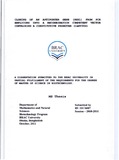Cloning of an antiporter gene (NHX1) from PCR amplicons into a recombination competent vector containing a constitutive promoter (caMV35S)

View/
Date
2011-10Publisher
BRAC UniversityAuthor
Razzaque, SamsadMetadata
Show full item recordAbstract
The costal belt of Bangladesh is under the threat of increasing salinity and thus reducing plant productivity. Consequently, salinity has become a major concern for ensuring food security. Salt tolerance is known to be a complex trait both genetically as well as physiologically and conferring this tolerance by introducing a single gene is therefore difficult. However, over expression of the vacuolar antiporter gene, NHX1 has been reported to provide salinity tolerance to a good extent. This work was carried out to clone the coding sequence of the rice antiporter gene (applying Gateway Technology) in a binary vector (pH7WG2.0) from where this can be easily introduced into a plant genome with a highly efficient constitutive promoter (CaMV35S). In this study, NHX 1 gene was first cloned into pENTR and confirmed the insertion through PCR, Restriction Digestion and Sequencing technique. Then the gene of interest was recombined
from pENTR to the Destination vector (pH7WG2.0) and recombination was confirmed by PCR and Restriction Digestion respectively. Finally, recombinant vector was then transformed into Agrobacterium (the transformation was also confirmed by PCR and Restriction Digestion) to perform Agrobacterium mediated transformation into tomato plant.
